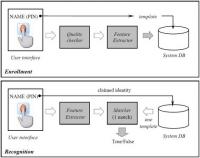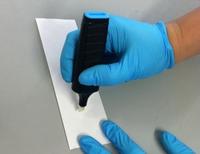-
Selfies could replace security passwords – but only with an upgrade

The next time you do some online shopping or call your bank, you may find you no longer have to scrabble around to remember your security password. Banks are increasingly turning to voice recognition technology as their preferred way of ensuring customers are who they say they are when they use telephone banking services. But does this kind of technology really mean that you’ll soon be able to just forget your passwords? The short answer right now is “no.”
-
-
Vulnerability found in in two-factor authentication

Two-factor authentication is a computer security measure used by major online service providers to protect the identify of users in the event of a password loss. Security experts have long endorsed two-factor authentication as an effective safeguard against password attacks. But what if two-factor authentication could be cracked not by computer engineering but by social engineering?
-
-
Forge-proof authentication method to revolutionize security
Scientists have discovered a way to authenticate or identify any object by generating an unbreakable ID based on atoms. The technology uses next-generation nanomaterials to enable the unique identification of any product with guaranteed security. uses atomic-scale imperfections which are impossible to clone as they comprise the unmanipulable building blocks of matter. The researchers used atomic-scale imperfections which are impossible to clone as they comprise the unmanipulable building blocks of matter.
-
-
Residents of 4 states may need more than a driver license to board domestic flights
Residents of four states — New York, New Hampshire, Minnesota, and Louisiana – may soon need more than their driver’s licenses as a means of identification when boarding an aircraft for a domestic flight, DHS says. These states’ licenses do not meet the standards stipulated by DHS under the latest phase of the federal Real ID Act of 2005. Residents from these four states will have to present their passports with them, or some other means of DHS-approved identification, before being allowed on board.
-
-
Bringing contactless fingerprint technology to market

Quickly moving through security checkpoints by showing your hand to a scanner seems straight out of science fiction, but work is being done to bring fast, touchless fingerprint readers out of the lab and into the marketplace. The touchless technology offers speed and a hygienic alternative to conventional fingerprint readers.
-
-
California offers driver's licenses to undocumented immigrants
This year California has begun to offer y undocumented immigrants driver’s licenses, and tens of thousands of immigrants have been standing long hours in line at the Department of Motor Vehicles offices around the state to avail themselves of the new document. DMV officials say that of the 883,000 licenses issued so far this year, 443,000 were issued to undocumented immigrants. The officials estimate that by the end of 2017, the DMV will issue more than 1.5 million driver’s licenses to undocumented immigrants in the state.
-
-
DHS awards $58.9 million biometric support contract to Ideal Innovations, Inc.
Arlington, Virginia-based Ideal Innovations, Inc. (I3) has been awarded a contract by the Department of Homeland Security (DHS)’s Office of Biometric Identity Management (OBIM) to provide specialized fingerprint analysis in support of OBIM’s Biometric Support Center (BSC). The BSC provides fingerprint identification services when the automated matching capabilities of DHS’s central repository cannot determine whether two sets of fingerprints match.
-
-
Biometric technologies have failed to guarantee integrity of elections in Africa
As Nigerians voted this past weekend in the 2015 presidential elections, there were many reports of technical problems with electronic fingerprint readers, intended to verify voters’ identities before they cast their ballots.At least twenty-five African countrieshave held elections with voters using some sort of electronic voting system. Many of these efforts have failed. Experts say that African governments should not divert public funds to expensive electronic voting systems, and use these funds instead on ways to eliminate voter intimidation, post-election violence, and ballot fraud — all of which are attributes of current election periods regardless of how votes are submitted.
-
-
Biometric security could do away with passwords
With hackers and cyber thieves running rampant online, efforts to create stronger online identity protection are leading major tech firms to invest in biometric security methods. Analysts predict that 15 percent of mobile devices will be accessed with biometrics in 2015, and the number will grow to 50 percent by 2020.
-
-
Illinois scrambles to meet Real ID deadline
State officials in Illinois are working to make driver’s licenses and identification cards comply with the Real ID Act of 2005before commercial air travel restrictions are implemented in 2016. Illinois identification cards do not meet minimum standards mandated by Congress in 2005. The Real ID Act requires states to verify personal information of applicants including birth certificates. The information is then electronically scanned and stored in a federal database, and data can be shared among states and the federal government.
-
-
FBI’s biometric data center key to identifying Jihadi John
The FBI is unlikely to release details of how, working with allies in the United Kingdom, it managed to accomplish the task of identifying “Jihadi John” with only video footage of the suspect’s hidden face and a voice with a British accent. Identifying Mohammed Emwazi, a Kuwaiti-born, British-educated man in his mid-20s, was likely done at the FBI’s Criminal Justice Information Services Division(CJIS), which houses the bureau’s Biometric Center of Excellence(BCE). At BCE, the FBI uses the $1.2 billion dollar Next Generation Identification(NGI) software to scan photos, aliases, physical traits, fingerprints, and voiceprints. The software is interoperable with the Pentagon’s Automated Biometric Identification System(ABIS) and DHS’s Automated Biometric Identification System(IDENT).
-
-
Hair dye “CSI” could help police solve crimes
Criminals with a penchant for dyeing their hair could soon pay for their vanity, as scientists have found a way to analyze hair samples at crime scenes to rapidly determine whether it was colored and what brand of dye was used. Researchers showed that surface-enhanced Raman spectroscopy (SERS) could be used rapidly to confirm whether hair samples, even microscopic ones, were dyed and what brand of colorant was used.
-
-
Grants competition to improve security, privacy of online identity verification systems
The National Institute of Standards and Technology (NIST) is launching a competition for a fourth round of grants to pilot online identity verification systems that help improve the privacy, security, and convenience of online transactions. The pilot grants support the National Strategy for Trusted Identities in Cyberspace (NSTIC), a White House initiative launched in 2011. NSTIC’s goal is to improve trust online through the creation of a vibrant “Identity Ecosystem,” in which individuals and organizations are able to better trust one another because they follow agreed-upon standards and processes for secure, privacy-enhancing and interoperable identity solutions online.
-
-
A crime-fighting “magic” marker pen picks up hidden fingerprints

A crime-fighting “magic” marker pen that can identify the hidden properties of receipts containing fingerprint deposits within a matter of seconds will be demonstrated at the Knowledge Transfer Network’s (KTN) Applications of Forensic Science Research and Development Technology Showcase 2014 event today (8 October) in London.
-
-
Experts urge caution in relying upon eyewitness identifications in criminal cases
A new report from the National Research Council recommends best practices that law enforcement agencies and courts should follow to improve the likelihood that eyewitness identifications used in criminal cases will be accurate. Science has provided an increasingly clear picture of the inherent limits in human visual perception and memory that can lead to errors, as well as the ways unintentional cues during law enforcement processes can compromise eyewitness identifications, the report says.
-
- All
- Regional
- Water
- Biometrics
- Borders/Immig
- Business
- Cybersecurity
- Detection
- Disasters
- Government
- Infrastructure
- International
- Public health
- Public Safety
- Communication interoperabillity
- Emergency services
- Emergency medical services
- Fire
- First response
- IEDs
- Law Enforcement
- Law Enforcement Technology
- Military technology
- Nonlethal weapons
- Nuclear weapons
- Personal protection equipment
- Police
- Notification /alert systems
- Situational awareness
- Weapons systems
- Sci-Tech
- Sector Reports
- Surveillance
- Transportation
Advertising & Marketing: advertise@newswirepubs.com
Editorial: editor@newswirepubs.com
General: info@newswirepubs.com
2010-2011 © News Wire Publications, LLC News Wire Publications, LLC
220 Old Country Road | Suite 200 | Mineola | New York | 11501
Permissions and Policies
Editorial: editor@newswirepubs.com
General: info@newswirepubs.com
2010-2011 © News Wire Publications, LLC News Wire Publications, LLC
220 Old Country Road | Suite 200 | Mineola | New York | 11501
Permissions and Policies
